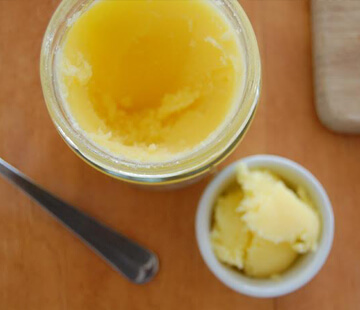
Debunked

Ghee is just unnecessary calories
It’s a saturated fat so it’s unhealthy

Quite contrary ghee helps in digesting the carbohydrates and proteins in your meal
Ghee may be a saturated fat but it contains Short-chain triglycerides or short-chain-fatty acids, which the body can easily metabolize if eaten in the right quantities.
Nourishing GOOD fat especially for the brain, which is essentially made up of fatty acids. Ghee helps in enhancing memory and nourishes the nervous system.
Ghee ignites gallbladder by ‘oleating’ or oiling it which in turn attracts toxins in the body that were preventing fat burning. In short, eat ghee fat to shed body fat!
Ghee has anti-inflammatory properties which are documented to show treatment of burns, swelling and pain
Ghee has a high smoking point and so cooking food in it at high temperatures doesn’t break its nutrients. When this happens, free radicals are released and these are harmful to our bodies
Like anything else, excess is bad and unhealthy. One tablespoon of ghee has 135 calories all from fat and so those who are overweight and diseased certainly cannot use it liberally. Excess consumption especially without exercise can lead to cardiac problems, hypertension, liver problems and obesity.
The golden drops of ghee that are drizzled upon your rice & lentils or onto your ‘chapatti’ (Indian flatbread) helps in lowering the Glycemic Index of the food portion. Glycemic index tells us the rate at which sugar is released into the blood stream. High Glycemic index foods like chocolate bars and pizzas sharply spike the sugar levels in the blood. This confuses the body into thinking it has excess (even if you have eaten just half a chocolate bar or one slice of pizza) and it immediately converts and stores it into fat thinking that for now it doesn’t need so much and will use it later. Low Glycemic index foods like sweet potatoes and brown rice slowly and steadily release sugar into the bloodstream and so the body metabolizes it efficiently and wholly. Ghee atop the carbs & proteins of your meal lowers the overall Glycemic index ensuring that the body fruitfully metabolizes and utilizes the nutrients being ingested.
I bet “they” didn’t tell you this vital fact when demonizing the saturated fat in ghee, did they? Guess our grandmothers knew a thing or too when they labeled that generous dousing of ghee as ‘love’. And of course the food just smelt and tasted heavenly! Even the ‘desi tadka’ (Indian tempering of dishes) which is essentially spices fried in ghee and added to dishes just before serving has a physiological reason for it ; the ghee helps in transporting the herbs and spices to the body’s cells and the spices themselves have a thermogenic effect on the body’s metabolism which means that the body has to work harder (i.e. burn more calories) to digest it. Eating burns calories!
Ghee apart from bettering and aiding in the digestion of food has several elements that make it very important to incorporate into our daily diets:
Butyrate, a short-chain-fatty-acid in ghee helps to decrease intestinal inflammation and improve the intestinal walls. It also promotes the production of fighter cells thereby boosting the immune system.
Conjugated Linoleic Acid (CLA), an antioxidant, has shown to improve insulin resistance, protect against artery plaques (blockages) and potentially have anti-carcinogenic properties.
Vitamin K2 present in ghee is one which is deficient in a lot of people and there is much evidence and research today which is suggesting and pointing to the fact that a deficiency of this very vitamin is what causes heart/cardiovascular disease in the first place. So a lack of ghee can be the reason your heart’s arteries may be clogged! K2 plays an important role in facial and dental development as well and so eat ghee to ensure glowing skin and healthier teeth.
Ghee has fat-soluble vitamins A, D, E and K as well as Omega 3 and 9 fats which boost immunity, have anti-ageing properties, are critical for maintaining healthy lustrous skin and hair and are known to boost libido and mood. Vitamin A in particular is extremely important to protect the integrity of the eye and ensure there is no degeneration of retinal cells and tissue.
Beware of vegetable ghee, which is sold with that sneaky “low-cal” label. It’s not only a lie but because this ghee is processed and made in a factory, it is higher in long-chain-fatty-acids which are bad for cholesterol levels, the heart and overall weight gain. Dairy ghee all the way people! Other wolves in sheeps’ clothing to avoid are sunflower, corn and cottonseed oils which are high in poly-unsaturated-fats and long-chain-fatty acids. Stick to frying/cooking in ghee!
And get this – eating ghee on a regular daily basis in the right amount along with exercise 3-4 times a week can not only promote shedding of body fat but also the build up of muscle mass. Eat ghee for a leaner and more toned body. If after reading all of this you’re not convinced then I doubt you ever will be! But for those that are, please do remember to ‘dress up’ your food in a teaspoon of ghee in your next meal and savor the flavor and its nutrition GUILT-FREE ☺

Juggling many roles from physician to writer to pilates instructor to Marketing-PR executive, Dr. Daamini is constantly pushed and inspired to get creative on how to encompass a Retreat into her daily life.
View Profile